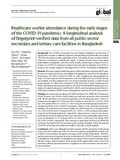| dc.contributor.author | Do, Duy | |
| dc.contributor.author | Sarker, Malabika | |
| dc.contributor.author | Chen, Simiao | |
| dc.contributor.author | Lenjani, Ali | |
| dc.contributor.author | Tikka, Pauli | |
| dc.contributor.author | Bärnighausen, Till | |
| dc.contributor.author | Geldsetzer, Pascal | |
| dc.date.accessioned | 2022-04-12T06:19:43Z | |
| dc.date.available | 2022-04-12T06:19:43Z | |
| dc.date.copyright | 2020 | |
| dc.date.issued | 2020-12-01 | |
| dc.identifier.citation | Do, D., Sarker, M., Chen, S., Lenjani, A., Tikka, P., Bärnighausen, T., & Geldsetzer, P. (2020). Healthcare worker attendance during the early stages of the COVID-19 pandemic: A longitudinal analysis of fingerprint-verified data from all public-sector secondary and tertiary care facilities in Bangladesh. Journal of Global Health, 10(2), 020509. doi:10.7189/jogh.10.020509 | en_US |
| dc.identifier.uri | http://hdl.handle.net/10361/16540 | |
| dc.description | This article was published in The Journal of Global Health [ © 2020 The Author(s)
JoGH © 2020 ISGH] and the definite version is available at: https://doi.org/10.1101/2020.09.01.20186445 The Journal's website is at: https://jogh.org/documents/issue202002/jogh-10-020509.pdf | en_US |
| dc.description.abstract | Background The COVID-19 pandemic has overwhelmed hospitals in several areas in
high-income countries. An effective response to this pandemic requires health care workers
(HCWs) to be present at work, particularly in low- and middle-income countries (LMICs)
where they are already in critically low supply. To inform whether and to what degree
policymakers in Bangladesh, and LMICs more broadly, should expect a drop in HCW attendance as COVID-19 continues to spread, this study aims to determine how HCW attendance has changed during the early stages of the COVID-19 pandemic in Bangladesh.
Methods This study analyzed daily fingerprint-verified attendance data from all 527 public-sector secondary and tertiary care facilities in Bangladesh to describe HCW attendance
from January 26, 2019 to March 22, 2020, by cadre, hospital type, and geographic division. We then regressed HCW attendance onto fixed effects for day-of-week, month,
and hospital, as well as indicators for each of three pandemic periods: a China-focused
period (January 11, 2020 (first confirmed COVID-19 death in China) until January 29,
2020), international-spread period (January 30, 2020 (World Health Organization’s declaration of a global emergency) until March 6, 2020), and local-spread period (March 7,
2020 (first confirmed COVID-19 case in Bangladesh) until the end of the study period).
Findings On average between January 26, 2019 and March 22, 2020, 34.1% of doctors,
64.6% of nurses, and 70.6% of other health care staff were present for their scheduled
shift. HCWs’ attendance rate increased with time in 2019 among all cadres. Nurses’ attendance level dropped by 2.5% points (95% confidence interval (CI)=-3.2% to -1.8%)
and 3.5% points (95% CI=-4.5% to -2.5%) during the international-spread and the local-spread periods of the COVID-19 pandemic, relative to the China-focused period.
Similarly, the attendance level of other health care staff declined by 0.3% points (95%
CI=-0.8% to 0.2%) and 2.3% points (95% CI=-3.0% to -1.6%) during the international-spread and local-spread periods, respectively. Among doctors, however, the international-spread and local-spread periods were associated with a statistically significant increase in attendance by 3.7% points (95% CI=2.5% to 4.8%) and 4.9% points (95%
CI=3.5% to 6.4%), respectively. The reduction in attendance levels across all HCWs
during the local-spread period was much greater at large hospitals, where the majority
of COVID-19 testing and treatment took place, than that at small hospitals.
Conclusions After a year of significant improvements, HCWs’ attendance levels among
nurses and other health care staff (who form the majority of Bangladesh’s health care
workforce) have declined during the early stages of the COVID-19 pandemic. This finding may portend an even greater decrease in attendance if COVID-19 continues to spread
in Bangladesh. Policymakers in Bangladesh and similar LMICs should undertake major
efforts to achieve high attendance levels among HCWs, particularly nurses, such as by
providing sufficient personal protective equipment as well as monetary and non-monetary incentives | en_US |
| dc.language.iso | en_US | en_US |
| dc.publisher | Journal of Global Health | en_US |
| dc.relation.uri | https://jogh.org/documents/issue202002/jogh-10-020509.pdf | |
| dc.subject | COVID-19 | en_US |
| dc.subject | Healthcare workers | en_US |
| dc.subject | Attendance | en_US |
| dc.subject | Health system | en_US |
| dc.subject | Global health | en_US |
| dc.title | Healthcare worker attendance during the early stages of the COVID-19 pandemic: A longitudinal analysis of fingerprint-verified data from all public-sector secondary and tertiary care facilities in Bangladesh | en_US |
| dc.type | Journal Article | en_US |
| dc.description.version | Published | |
| dc.contributor.department | Brac James P. Grant School of Public Health | |
| dc.identifier.doi | 10.1101/2020.09.01.20186445 | |

